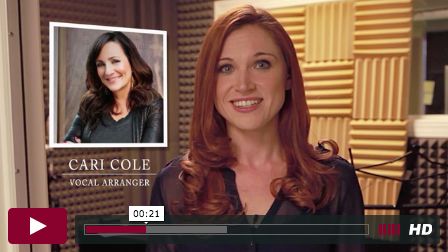by Cari Cole
So you want your vocals to make a big impression on your next record, but not sure your voice can deliver, or exactly how to do that? Or you can belt it out, but you don’t have folks praising your voice the way you secretly wish for?
Or maybe you get great praise, but secretly you know you could sound better? Matter of fact, listening to your voice is almost a disappointment to you? Your taste is ahead of your ability?
Or you either want to be an extraordinary singer or you just plain want to sound better, so that you don’t cringe on playback.
Yep, yep, I know exactly how you feel. I worked my voice to get it to where I wanted. It’s a process. And now, after coaching singers for 3 decades, I get the extreme satisfaction to make them sound better and achieve that voice they envision in their mind’s ear, and almost instantaneously.
Just last Friday, I was recording a budding singer-songwriter who I’ve been working with for the past year. She’s been writing songs for a while, but her voice has been lagging behind, so she sought me out and we got down to work. She’d worked with some big name coaches for years, but never was able to get anywhere. Matter of fact, she was pretty discouraged. But when I first heard her sing, I heard the sound that was buried inside entangled muscles and a lack of support ~ and I knew exactly what was going to happen. We were going to open her up and free that gorgeous instrument that was just waiting to be found.
First I got her vocalizing with certain voice building techniques to strengthen her voice, eliminate nasality and basically open up her voice. She was a trooper and did them every day. Additionally along the way, I started recording her voice to her own songs, not covers that are already interpreted by other singers. I started showing her how to develop her phrases (see below), and add tasty stylings, like little scoops, and easy small riffs to smooth out her sound. I showed her how to accent or push certain words to create a natural dynamic and super easy ways to do that without strain, but with instant results. We just kept chipping away at it, session by session.
Well, yesterday, all of those sessions came full circle in the session of the year. We got a killer vocal. It was smooth, free sounding, totally believable and emotional. So much so, that both of us were not only beaming from ear to ear, but we couldn’t stop hugging each other ;). It’s beyond fulfilling to take someone from a voice that is buried and entangled to it’s rightful free and powerful state. And, the best part for me? I’ve done this with thousands of singers. There has never been a voice that I couldn’t free.
Here’s some of what we did and what you can use on your next record to get those big beautiful vocals!
1. Separate your phrases
Too often singers try to sing the whole phrase in one breath as if that is some kind of feat. Actually, it loses impact that way. Contemporary vocals should be more conversational. And in conversation, we break up our phrases to make our point. Ever listen to one of those voices that ramble on and on so much that they put you to sleep? That’s because they blend everything together and as a result you can’t really hear what they are saying. Well, when you break up your phrase, you can hear the words more and connect to the emotion of the song more powerfully.
Adele is a master at phrasing. Besides her gorgeous vocal tone, phrasing is probably one of the biggest defining features about her voice. Listen to her song “Hello” while you look at these notes. See if you can delineate the difference between pauses, breaths, and micro-quick pauses (or stops) or breaths. Notice how she adds a short pause or takes a breath in unsuspecting places. She does that deliberately — to break up lyrics, to make her point more powerfully emotionally. Yeah, it’s deliberated magic!
For example:
“Hello, (pause) it’s me (pause, breath)
I was wondering if after all these years you’d like to meet (micro-quick pause)
To go over (pause) everything (breath)
They say that time’s supposed to heal ya (micro-quick pause)
But I ain’t done much healing (breath)
Hello, (pause) can you hear me? (pause, breath)
I’m in California dreaming about who we used to be (micro-quick breath)
When we were younger (pause) and free (breath)
I’ve forgotten how it felt (micro pause) before the world fell at our feet
There’s such a difference (breath) between us
And a million miles (pause, breath)
Hello from the other side (quick breath)
I must have called a thousand times (micro-quick breath)
To tell you I’m sorry (micro-quick pause) for everything that I’ve done
But when I call you (breath) never (breath) seem to be home
Hello from the outside (breath)
At least I can say that I’ve tried (pause, breath)
To tell you I’m (pause) sorry (breath) for breaking your heart
But it don’t matter it (pause) clearly (pause) doesn’t tear you apart (pause) anymore”
Using techniques like these will instantly make you sound more natural and deliver much more emotion.
2. Use Scoops to sound more natural
Scoops also make your voice sound more natural. Add a little scoop at the word that starts a phrase or in the middle of a phrase. But be sure you get all the way to the center height of the top note or you’ll fall flat (and that doesn’t sound good.)
3. Open your throat and drop your tongue if you sound too thin or nasal
One of the causes of nasality is a tongue that sits too high in your mouth during singing. A very effective approach is to think of yawning or drinking a sip of water right before you sing and then trying to keep the tongue down in the back. This creates more of an “open throat” and decreases nasality. Singers are often more nasal or “thinner” sounding on high notes as the tongue jumps up to “help”. This is something that cannot be forced, and has to be practiced over time. Practice vocal exercises in this manner so you can build the right muscle memory to achieve this technique. Some singers get this quicker than others. Depends on how stubborn or tense your tongue is!
4. De-emphasize certain troublesome consonants
Consonants like “w”, “l” and “r”’s are particularly problematic.
W has an oo at the top of the consonant. Don’t sing the “oo” but go towards the next vowel in the word. Like in the word “water”, try to sing “wAH- ter.” Emphasize the “AH” not the w.
L can be tricky with a tight tongue. Most people need to soften their tongue on L’s and use the technique mentioned above for w’s to pronounce the vowel following the “L” instead of focusing on the “L”. Occasional singers have a lazy front tongue (as in Asian accents) and in that case, you need to pronounce the L a little more.
R’s are tricky period. Think “uh-r” instead of a hard “R” to make it sound smoother and more natural.
Because we stretch words out as we sing, the consonants like these stand out a bit too much. Practice makes them smoother and less noticeable or awkward.
5. Watch out for diphthongs
A diphthong is a sound made by combining two vowels, specifically when it starts as one vowel sound and goes to another, like the oy (oh-ee) sound in oil. Diphthong comes from the Greek word “diphthongos” which means “having two sounds.”
In singing, sit on the first vowel and ignore the second. If you land too hard on the second vowel it makes you sound amateur and less smooth.
There are 3 main diphthongs. Ay-ee, i-ee and oh-oo. Like in the words “stay-ee”, “My-ee” and “Whoa-oo”. Drop the second vowel to sound like a serious pro!
6. Decrease volume on the last few notes of a descending riff
So your riff is a 3 note riff on the word “yeah”: “Yeah-ah-ah.” The first note is the loudest note that decreases in volume and trails off as you sing it. This makes your riff sound smooth and effortless rather than effortful ;).
Those are just a few of the many techniques I use as a vocal arranger that makes singers sound instantly better, and at the same time, brings more emotion to their recordings. It’s funny, you would think all of those technical things would make you sound stiff, but it actually has the opposite effect. It makes you sound totally believable and exceedingly more emotional.
I hope this helps you rock your next vocal recording and get those big, beautiful vocal tracks blaring across your speakers!
The post Getting Big Vocals On Your Next Record appeared first on Cari Cole Music Co..




